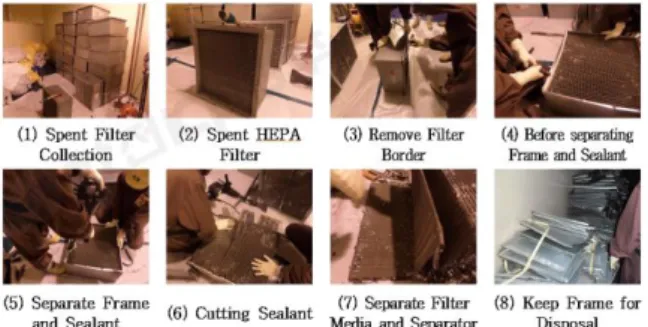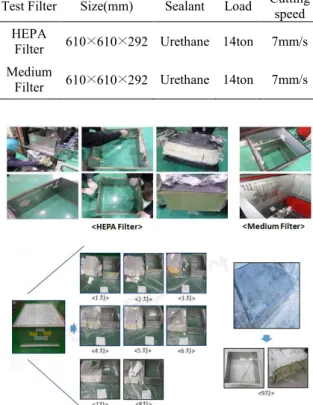2019 ⦽ǎႊᔍᖒ⠱ʑྜྷ⦺⫭ ⇹ĥ⦺ᚁݡ⫭ םྙ᧞Ḳ
217
Development of Pretreatment Technology of Radioactive HVAC Filter Waste
NakJeom Kim*, MinHwan Mo, YongHo Cho, and HeeCheol Yoon KEPCO KPS, 211, Munhwa-ro, Naju-si, Jeollanam-do, Republic of Korea
*
k1n2j3@naver.com
1. Introduction
A large amount of radioactive filter wastes spent in HVAC of commercial nuclear power plants and dismantled nuclear power plants should be separated by materials for disposal according to the regulation of medium and low level radioactive waste disposal.
If this works are done manually, there are problems that a lot of manpower should be input and a large amount of dust is generated during the works. Particularly, it is difficult and time-consuming to remove the adhesive of poly urethane material that sealed with filter media on filter frame because of hardening after use. This paper introduces automatic filter separation system as pretreatment technology of HVAC filter waste for treating filters by materials.
2. Methods and Results
2.1 Development Background
A HEPA filter consists of metal frame, glass fiber media, aluminum separator, poly urethane sealant etc as shown in Fig. 1 and Table 1. Therefore, in order to disposal contaminated filter wastes, the filter wastes should be separated by materials according to regulation on the disposal of low-level radioactive waste.
Fig. 1. HVAC System and Filters in NPP.
Table 1. HEPA Filter Materials
Parts Material
Frame Stainless Steel
Media Glass Fiber
Separator Aluminum
Sealant Poly Urethane
Gasket Neoprene rubber
Fig. 2 shows manual separation process of the spent filter. There are 8 stages for separating the spent filter and manpower for the process requires 0.8MD per a filter by manual. Especially cutting sealant stage which separates the filter media on the frame is most difficult and time consuming work.
Fig. 2. Manual Waste Filter Separation Process.
So we developed automatic filter separation system that can reduce manpower and exposure time of workers and minimize dust during operation as shown Fig. 3.
218
2019 ⦽ǎႊᔍᖒ⠱ʑྜྷ⦺⫭⇹ĥ⦺ᚁݡ⫭םྙ᧞Ḳ Fig. 3. Filter Separation System.2.2 Principle of Equipment
Automatic filter separation system equipped the
sizing mechanism and cutting mechanism to force the filter width to be constant because there is no clear standard about the width and tolerance of the filter frame which makes it difficult to develop standardized equipment.
Fig. 4 shows sizing and cutting device. Sizing device fix left side of the filter frame and press right side of the frame inward for making filter width uniform as shown fig 4. In case of cutting mechanism, the cutter moves up and down in the vertical direction to separate the sealant and filter frame. These devices make inside width of filters which have various size uniform.
Fig. 4. Flexible Cutting and sizing Device.
2.3 Performance Test
The performance test for the developed system was performed with the filters (HEPA filter 8ea, Medium filter 1ea) which used in the Han-ul #5 and #6. Test results showed good performance of separating sealant
on the filter frame as shown Fig. 5. As a result, one worker could separate seven filters using system in a day. That is, it is possible to improve 7 times of working efficiency compared with manual work that one worker could separate two filters in a day.
Table 2. Spent filter Specification and test condition Test Filter Size(mm) Sealant Load Cutting
speed HEPA
Filter 610Ý610Ý292 Urethane 14ton 7mm/s Medium
Filter 610Ý610Ý292 Urethane 14ton 7mm/s
Fig. 5. Performance Test Results using HEPA Filters.
3. Conclusion
We have developed automatic filter separation system for the separation of contaminated HVAC waste filters, which have been separated by manual work. And also on-site performance tests of the system have been performed. Developed systems are expected to be widely used as pretreatment technology for radioactive filter wastes generated from operating NPP and dismantled NPP in the future.

